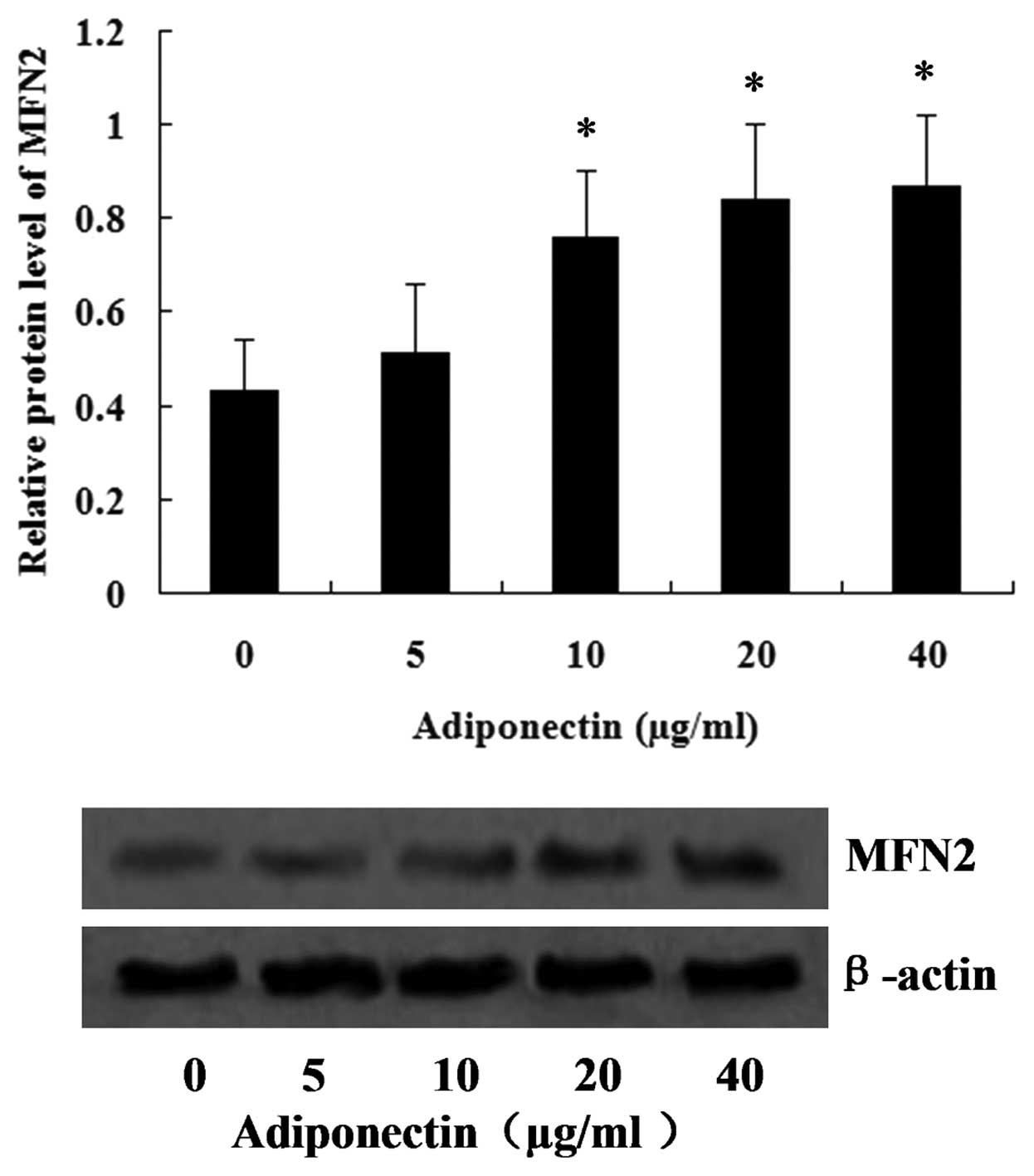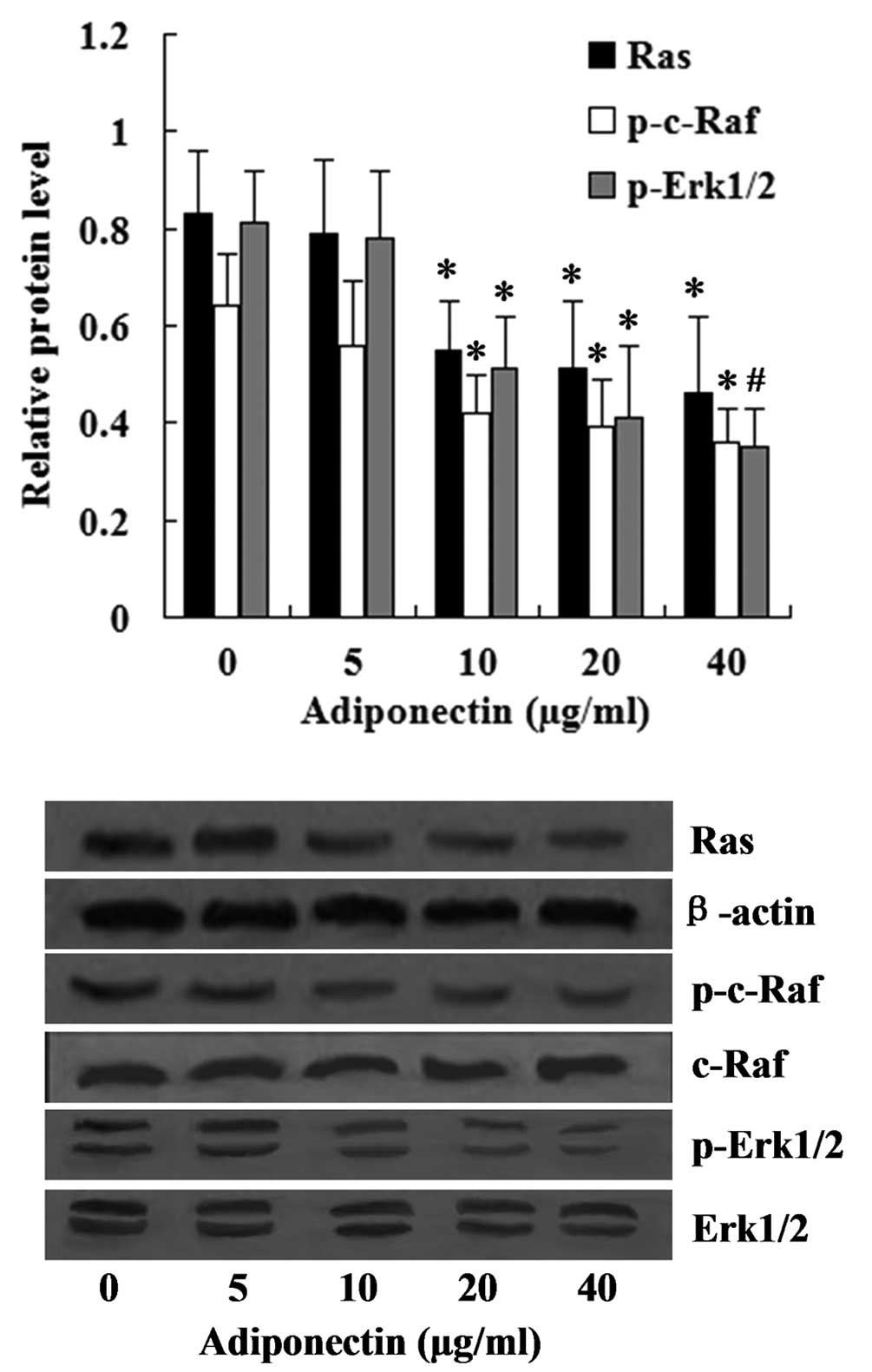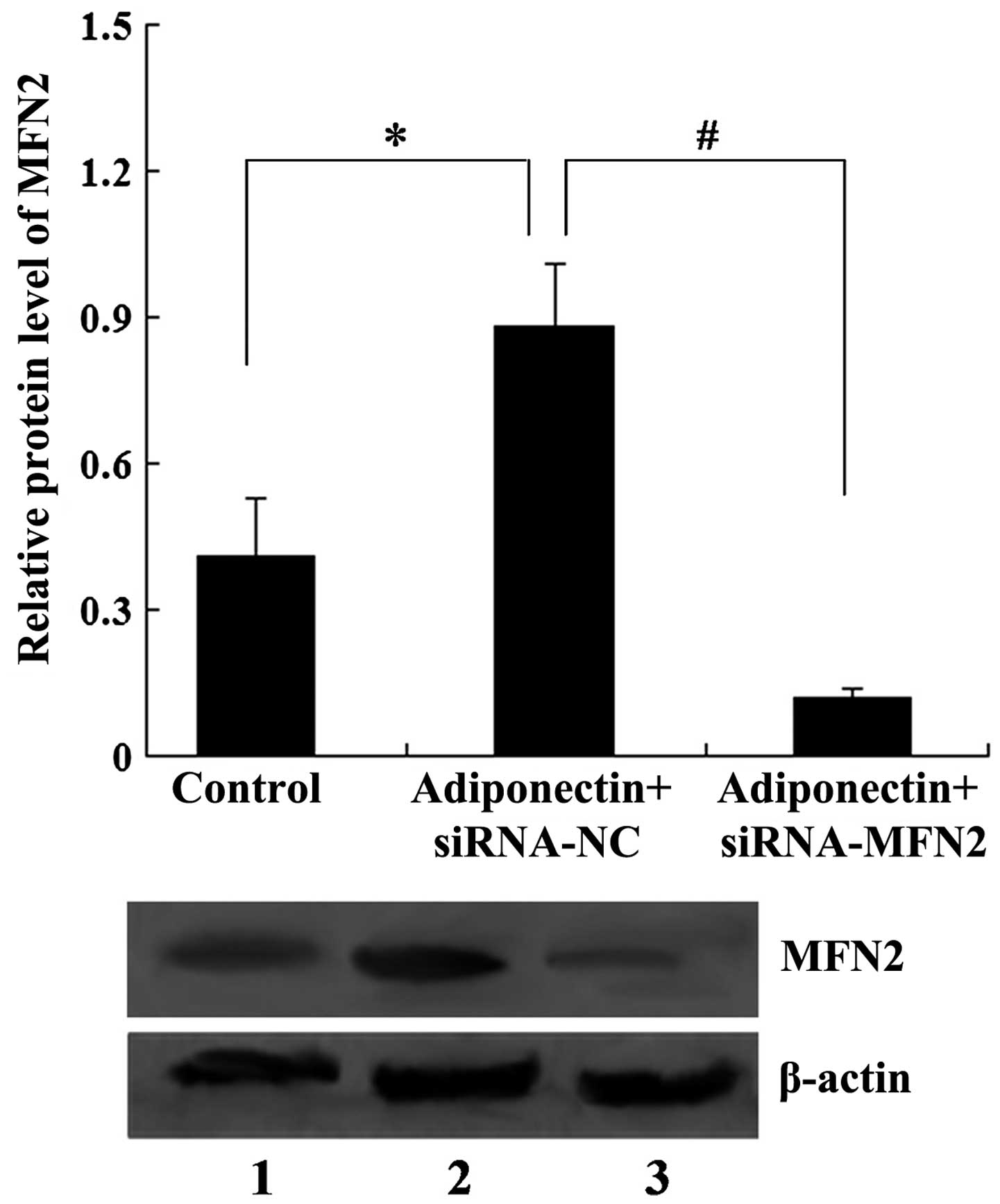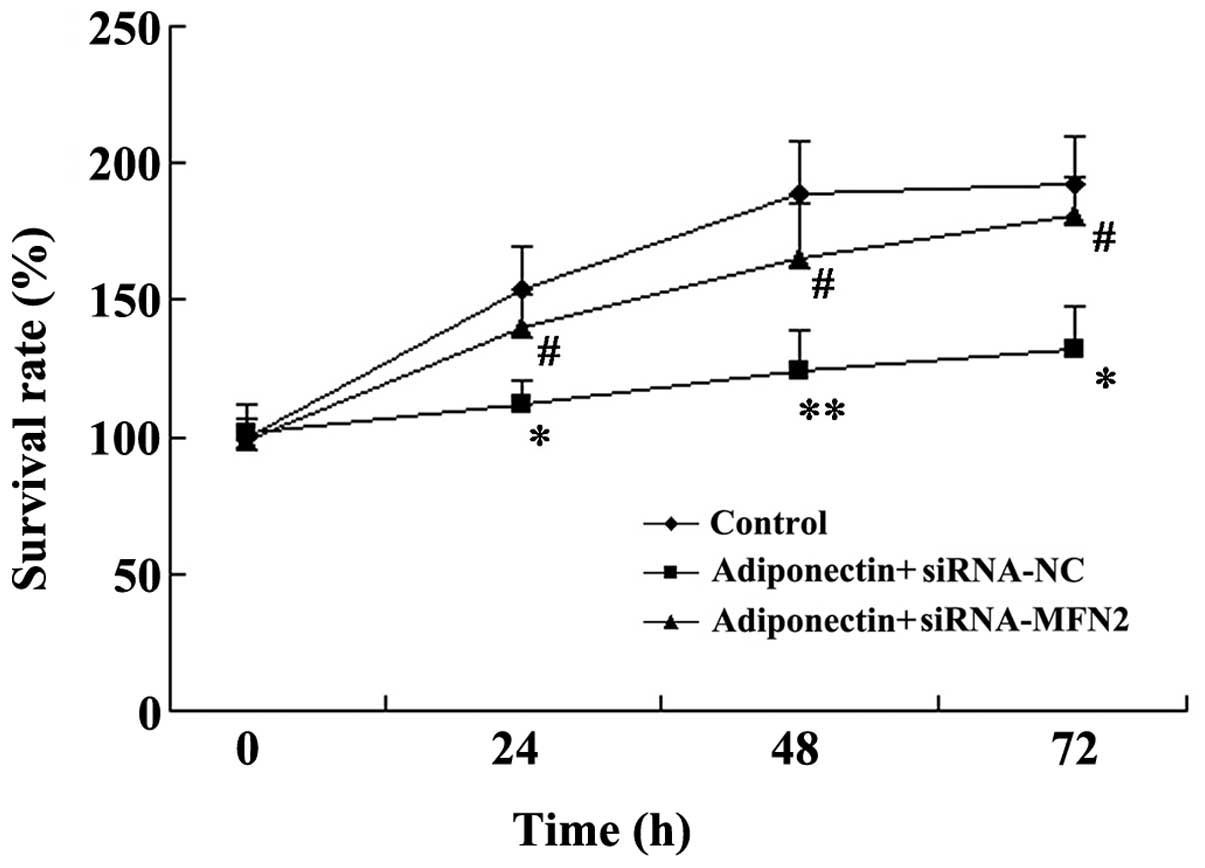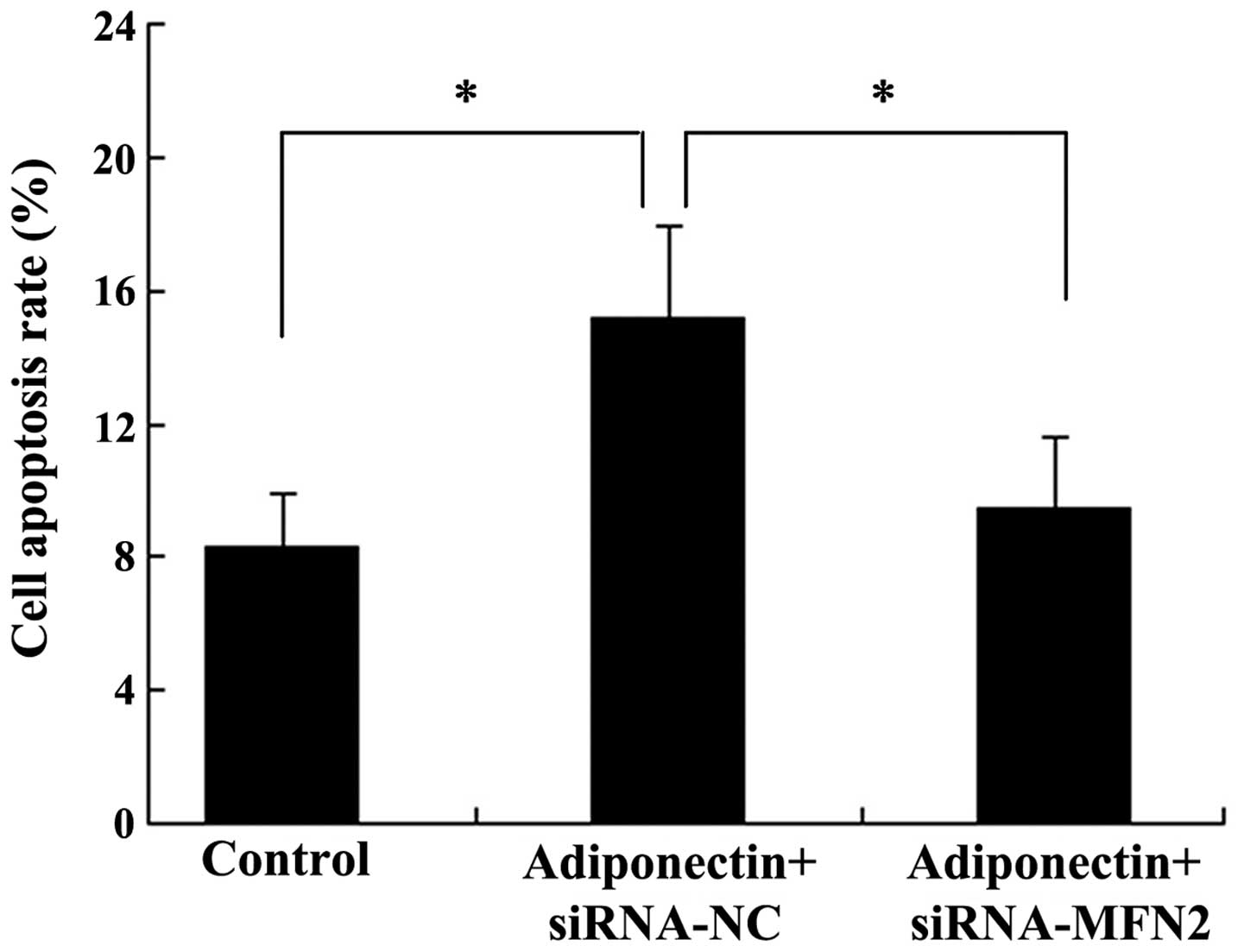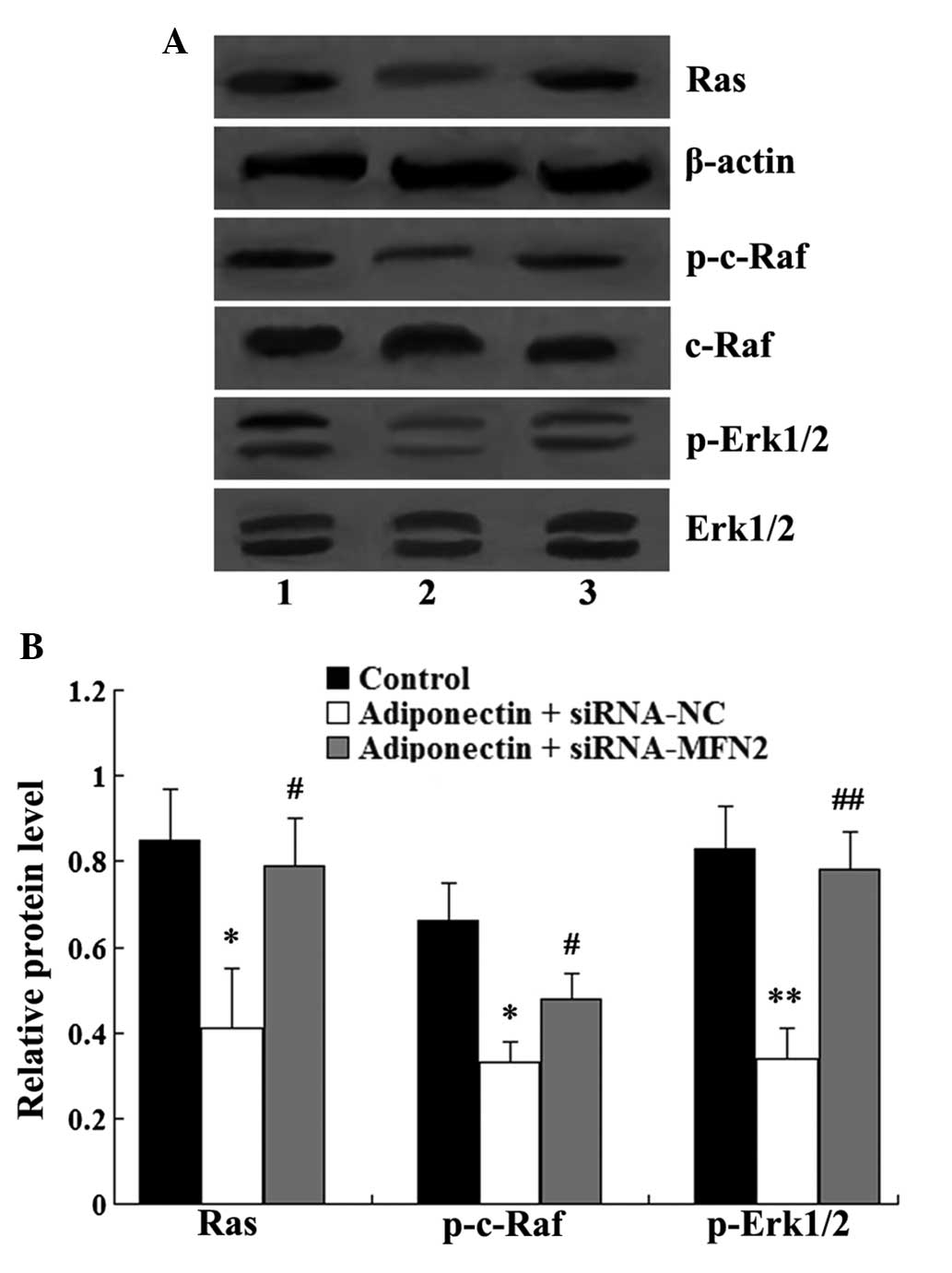Adiponectin affects vascular smooth muscle cell proliferation and apoptosis through modulation of the mitofusin-2-mediated Ras-Raf-Erk1/2 signaling pathway
- Authors:
- Published online on: June 8, 2015 https://doi.org/10.3892/mmr.2015.3899
- Pages: 4703-4707
Abstract
Introduction
Vascular smooth muscle cells (VSMCs) are an important constituent of vessel walls, and their dysfunction may lead to pathological processes and cause vascular disease. VSMCs undergo cell biological changes in response to a variety of cytokines and growth factors (1).
Adiponectin is an important adipocyte-derived hormone (2,3), which is well-known for its involvement in lipid and glucose metabolism and insulin sensitivity (4–7). Numerous studies have suggested that adiponectin has potent anti-inflammatory (8), athero-protective (9), antihypertensive (10) and antidiabetic (11) effects. A previous study demonstrated that adiponectin is also expressed and secreted by VSMCs (12), and adiponectin inhibits neointimal formation through suppression of the proliferation and migration of VSMCs (13–15). However, the mechanisms underlying the effect of adiponectin on VSMC proliferation and apoptosis require further investigation.
The present study aimed to investigate whether mitofusin-2 (MFN2) which mediates the effect of adiponectin on VSMC proliferation and apoptosis, which may provide a novel basis for the therapy of vascular disease.
Materials and methods
Cell culture
The Aortic Smooth Mus cells (VSMCs; cat. no. CC-2571) were purchased from Clonetics (San Diego, CA, USA). The VSMCs were cultured in Dulbecco's modified Eagle's medium (Gibco-BRL, Rockville, MD, USA) with 20% fetal bovine serum (Gibco-BRL) in a humidified atmosphere at 37°C of 5% CO2. The culture medium was replaced every 3 days.
Treatment of VSMCs with adiponectin
Adiponectin was purchased from Cayman Chemical Company (Ann Arbor, MI, USA) and dissolved in phosphate-buffered saline (1 mg/ml). To obtain different experimental concentrations (5, 10, 20 and 40 µg/ml), serial dilutions were prepared in the culture medium. VSMCs (5×105 cells/ml) were seeded into 6-well plates and when the VSMCs reached 80% confluence, adiponectin was added to treat the cells for 24 h at 37°C.
Transfection
The cells were seeded into 6-well plates at a density of 3×105 cells/well and allowed to grow for 24 h. MFN2 small interfering (si)RNA, forward 5′-CCAUGAGGCCUUUCUCCTT-3′ and reverse 5′-GGAGAAAGGCCUCAUGGTT-3′; or control siRNA, forward 5′-UUCUCCGAACGUGUCACGUTT-3′ and reverse 5′-ACGUGACACGUUCGGAGAATT-3′. were synthesized at Sangon Biotech Inc. (Shanghai, China) and transfected into the cells at a final concentration of 2 µM using lipofectamine 2000 transfection reagent (Invitrogen Life Technologies, Carlsbad, CA, USA), according to the manufacturer's instructions.
Flow cytometry assay
For cell apoptosis analysis using flow cytometry, the cells were harvested and fixed in 70% ethanol (Xinyu Inc., Shanghai, China) on ice. Following centrifugation at 1,000 × g for 5 min at room temperature, the cells were stained with annexin V and propidium iodide (Kaiji Biological Inc., Nanjing, China), according to the manufacturer's instructions, and analyzed using flow cytometry (FC 500 MPL system; Beckman Coulter, Inc., Miami, FL, USA).
MTT assay
The cells were seeded into 96-well plates at a density of 4×103 cells/well. Following treatment with adiponectin for 24, 48 and 72 h, 10 µl MTT solution (Sigma-Aldrich, St. Louis, MO, USA) was added to each well, and the incubation was continued for 4 h at 37°C. The formazan was solubilized in dimethyl sulfoxide (Sigma-Aldrich) and the viable cells were determined by measuring the absorbance at 570 nm using a microplate reader (Multiskan Ascent 354; Thermo Labsystems, Waltham, MA, USA).
Western blot analysis
The proteins from cultured cells were extracted using cell lysis buffer, containing 50 mM Tris (Amresco LLC, Solon, OH, USA), 150 mM NaCl (Tianjin Dingshengxin Chemical Industry Co., Ltd., Tianjin, China), 1 mM EDTA (Zhiyuan, Inc., Tianjin, China), 1% Triton X-100 (Amresco LLC), 1 mM sodium orthovanadate (Beyotime Institute of Biotechnology, Shanghai, China), 1 mM PMSF (Amresco LLC) and 2 mM DTT (pH 7.4; Amresco LLC). Protein concentrations were quantified using a bicinchoninic acid assay method, using reagents purchased from Pierce Biotechnology, Inc. (Rockford, IL, USA). Equal quantities of the cell lysates were separated on 12% SDS-PAGE (Invitrogen Life Technologies, Carlsbad, CA, USA), and then transferred on to polyvinylidene difluoride membranes (Millipore, Billerica, MA, USA) via electroblotting. The membranes were blocked with Tris-buffered saline containing 5% bovine serum albumin (Sigma-Aldrich) at 37°C for 1 h. The blot was then probed with mouse monoclonal antibody against MFN2 (sc-100560; 1:500; Santa Cruz Biotechnology, Inc., Santa Cruz, CA, USA), mouse monoclonal antibody against Ras (sc-166691; 1:800; Santa Cruz Biotechnology, Inc.), mouse monoclonal antibody against c-Raf (#12552; 1:400; Cell Signaling Technology, Inc., Beverly, MA, USA), rabbit monoclonal antibody against extracellular signal regulated kinase (Erk)1/2 (#4695; 1:400; Cell Signaling Technology, Inc.), rabbit monoclonal antibody against phosphorylated (p)-c-Raf (Ser338; #9427; 1:400; Cell Signaling Technology, Inc.) and rabbit monoclonal antibody against p-Erk1/2 (Thr202/Tyr204; #4377; 1:400; Cell Signaling Technology, Inc.). Subsequently, the membranes were incubated with horseradish peroxidase (HRP)-conjugated secondary antibody [goat anti-rabbit IgG/HRP (sc-2004; 1:10,000) and goat anti-mouse IgG/HRP (sc-2031; 1:10,000); Santa Cruz Biotechnology, Inc.)] at 37°C for 1 h. The signals were detected using an enhanced chemiluminescence western blotting kit (Pierce Biotechnology, Inc).
Statistical analysis
All data are expressed as the mean ± standard deviation of at least three independent experiments. Comparisons of the parameters between the two groups were performed using Student's t-test. SPSS software, version 19 (IBM SPSS, Armonk, NY, USA) was used for statistical analysis. P<0.05 was considered to indicate a statistically significant difference.
Results
Adiponectin induces the expression of MFN2 in VSMCs
To investigate the effect of adiponectin on the expression of MFN2, the VSMCs were treated with adiponectin at concentrations between 5 and 40 µg/ml, and, after 24 h, the expression of MFN2 in the VSMCs was assessed using western blot analysis. The results are shown in Fig. 1, and revealed that the expression of MFN2 increased with increasing concentrations of adiponectin. Concentrations between 10 and 40 µg/ml adiponectin significantly increased the expression of MFN2, with the peak value observed at 40 µg/ml (P<0.05).
Inhibition of the Ras-Raf-Erk1/2 signaling pathway following treatment with adiponectin
The Ras-Raf-Erk1/2 pathway is one of the most important downstream signaling cascades of MFN2. The effect of adiponectin on the expression levels of Ras, p-c-Raf and p-Erk1/2 was investigated in the present study. The relative expression level of Ras was normalized to that of β-actin, while the relative expression levels of the phosphorylated forms of c-Raf and Erk1/2 were normalized to the levels of total c-Raf and Erk1/2. The western blot analysis revealed that the relative expression levels of Ras, p-c-Raf, p-Erk1/2 in the VSMCs were significantly inhibited by adiponectin at concentrations between 10 and 40 µg/ml (P<0.05) (Fig. 2).
MFN2 knockdown attenuates the inhibitory effect of adiponectin on VSMC proliferation
To examine whether MFN2 was involved in the effect of adiponectin on VSMC proliferation, siRNA-MFN2 was transfected into VSMCs for 24 h to knock down the expression of MFN2, following which the VSMCs were treated with 40 µg/ml adiponectin for another 24 h. The results revealed that 40 µg/ml adiponectin upregulated the expression of MFN2 in the VSMCs (P<0.05). However, the expression ofMFN2 was suppressed by transfection with siRNA-MFN2, with the expression of MFN2 significantly decreased in the adiponectin + siRNA-MFN2 group, compared with the adiponectin + siRNA-control group (P<0.01; Fig. 3).
An MTT assay was used to examine VSMC proliferation. As shown in Fig. 4, the VSMC survival rates decreased significantly following treatment with adiponectin (P<0.05). However, MFN2-knockdown attenuated the inhibitory effect of adiponectin on VSMC proliferation, and the VSMC survival rates were significantly increased in the adiponectin + siRNA-MFN2 group, compared with the adiponectin + siRNA-control group (P<0.05; Fig. 4).
MFN2 knockdown attenuates adiponectin-induced apoptosis in VSMCs
Subsequently, the present study examined whether MFN2 was involved in the effect of adiponectin on VSMC apoptosis. The VSMCs were transfected either with siRNA-MFN2 or siRNA-control for 24 h, followed by treatment with 40 µg/ml adiponectin for another 24 h. Subsequently, the VSMCs were harvested for flow cytometric analysis. As shown in Fig. 5, the apoptotic rate of the cells in the control group was 8.3±1.6%, whilst treatment with adiponectin significantly induced cell apoptotic rates to 15.2±2.7% (P<0.05). The apoptotic rate of the cells in the adiponectin + siRNA-MFN2 group (9.5±2.1%) was significantly different from the adiponectin + siRNA-control group (15.2±2.7%) (P<0.05).
MFN2 knockdown attenuates the inhibitory effect of adiponectin on the Ras-Raf-Erk1/2 signaling pathway
Western blot analysis was used to assess the role of MFN2-knockdown in the inhibitory effect of adiponectin on the Ras-Raf-Erk1/2 signaling pathway. As shown in Fig. 6, adiponectin significantly inhibited the relative expression levels of Ras (P<0.05), p-c-Raf (P<0.01) and p-Erk1/2 (P<0.01) in the VSMCs. However, MFN2-knockdown attenuated the inhibitory effect of adiponectin, and the relative expression levels of Ras, p-c-Raf and p-Erk1/2 were significantly increased in the adiponectin + siRNA-MFN2 group, compared with the adiponectin + siRNA-control group (P<0.05).
Discussion
It has been previously demonstrated that adiponectin is involved in the protection of vascular injury by suppressing neointimal formation (16,17). The present study demonstrated that adiponectin exhibited an inhibitory effect on VSMC proliferation and induced cell apoptosis, and these findings were consistent with those of previous studies (13–15,18).
As mentioned previously, certain genes and signaling pathways have been implicated in the effect of adiponectin on cell growth (19–22). In the present study, MFN2 and its downstream signaling cascade, the Ras-Raf-Erk1/2 signaling pathway, were investigated.
MFN2 is a mitochondrial membrane protein, which is primarily involved in mitochondrial fusion (23). MFN2 acts as a suppressor in cell proliferation and as a promoter of cell apoptosis (24–28). It was revealed in the present study that siRNA-mediated downregulation of MFN2 in the VSMCs attenuated the effect of adiponectin on VSMC proliferation and apoptosis, therefore the results demonstrated that MFN2 was involved in the effect of adiponectin on VSMC proliferation and apoptosis. In addition, it was revealed that adiponectin significantly increased the expression of MFN2 in a concentration-dependent manner.
Previous studies have indicated that the Ras-Raf-Erk1/2 signaling pathway is the downstream signaling cascade of MFN2 (29,30). Following activation of Ras, it couples with Raf directly and the cellular Raf protein is phosphorylated, the downstream signaling transduction pathways are then activated, leading to the phosphorylation of Erk1 and Erk2. The activated Erk1/2 protein contributes to the growth of VSMCs (31,32). However, MFN2 acts as a negative regulator of the Ras-Raf-Erk1/2 signaling pathway through its interaction with Ras (29). In the present study, the results demonstrated that, in the VSMCs, adiponectin significantly inhibited the expression levels of Ras, p-c-Raf and p-Erk1/2, however, MFN2 knockdown attenuated the inhibitory effect of adiponectin. This demonstrated that MFN2 mediated the effects of adiponectin on the Ras-Raf-Erk1/2 signaling pathway.
In conclusion, the present study demonstrated for the first time, to the best of our knowledge, that adiponectin exhibited an inhibitory effect on VSMC proliferation, and induced cell proliferation via regulation of the expression of MFN2. Adiponectin also upregulated the expression of MFN2, which inhibited the Ras-Raf-Erk1/2 signaling pathway, leading to the inhibition of VSMC proliferation and to the induction of VSMC apoptosis. The results of the present study improves and expands the current understanding of the effects of adiponectin on VSMCs and may provide novel targets for therapeutic intervention in vascular disease.
References
|
Kiyan Y, Limbourg A, Kiyan R, et al: Urokinase receptor associates with myocardin to control vascular smooth muscle cells phenotype in vascular disease. Arterioscler Thromb Vasc Biol. 32:110–122. 2012. View Article : Google Scholar | |
|
Matsuzawa Y, Funahashi T and Nakamura T: Molecular mechanism of metabolic syndrome X: contribution of adipocytokines adipocyte-derived bioactive substances. Ann N Y Acad Sci. 892:146–154. 1999. View Article : Google Scholar | |
|
Henry BA and Clarke IJ: Adipose tissue hormones and the regulation of food intake. J Neuroendocrinol. 20:842–849. 2008. View Article : Google Scholar : PubMed/NCBI | |
|
Yamauchi T, Kamon J, Waki H, et al: The fat-derived hormone adiponectin reverses insulin resistance associated with both lipoatrophy and obesity. Nat Med. 7:941–946. 2001. View Article : Google Scholar : PubMed/NCBI | |
|
Berg AH, Combs TP, Du X, Brownlee M and Scherer PE: The adipocyte-secreted protein Acrp30 enhances hepatic insulin action. Nat Med. 7:947–953. 2001. View Article : Google Scholar : PubMed/NCBI | |
|
Maeda N, Shimomura I, Kishida K, et al: Diet-induced insulin resistance in mice lacking adiponectin/ACRP30. Nat Med. 8:731–737. 2002. View Article : Google Scholar : PubMed/NCBI | |
|
Matsuzawa Y: Establishment of a concept of visceral fat syndrome and discovery of adiponectin. Proc Jpn Acad Ser B Phys Biol Sci. 86:131–141. 2010. View Article : Google Scholar : PubMed/NCBI | |
|
Wulster-Radcliffe MC, Ajuwon KM, Wang J, Christian JA and Spurlock ME: Adiponectin differentially regulates cytokines in porcine macrophages. Biochem Biophys Res Commun. 316:924–929. 2004. View Article : Google Scholar : PubMed/NCBI | |
|
Matsuda M, Shimomura I, Sata M, et al: Role of adiponectin in preventing vascular stenosis The missing link of adipo-vascular axis. J Biol Chem. 277:37487–37491. 2002. View Article : Google Scholar : PubMed/NCBI | |
|
Chen H, Montagnani M, Funahashi T, Shimomura I and Quon MJ: Adiponectin stimulates production of nitric oxide in vascular endothelial cells. J Biol Chem. 278:45021–45026. 2003. View Article : Google Scholar : PubMed/NCBI | |
|
Maeda N, Shimomura I, Kishida K, et al: Dietinduced insulin resistance in mice lacking adiponectin/ACRP30. Nat Med. 8:731–737. 2002. View Article : Google Scholar : PubMed/NCBI | |
|
Ding M, Carrão AC, Wagner RJ, et al: Vascular smooth muscle cell-derived adiponectin: a paracrine regulator of contractile phenotype. J Mol Cell Cardiol. 52:474–484. 2012. View Article : Google Scholar : | |
|
Matsuda M, Shimomura I, Sata M, et al: Role of adiponectin in preventing vascular stenosis. The missing link of adipo-vascular axis. J Biol Chem. 277:37487–37491. 2002. View Article : Google Scholar : PubMed/NCBI | |
|
Wang Y, Lam KS, Xu JY, Lu G, Xu LY, Cooper GJ and Xu A: Adiponectin inhibits cell proliferation by interacting with several growth factors in an oligomerization-dependent manner. J Biol Chem. 280:18341–18347. 2005. View Article : Google Scholar : PubMed/NCBI | |
|
Motobayashi Y, Izawa-Ishizawa Y, Ishizawa K, et al: Adiponectin inhibits insulin-like growth factor-1-induced cell migration by the suppression of extracellular signal-regulated kinase 1/2 activation, but not Akt in vascular smooth muscle cells. Hypertens Res. 32:188–193. 2009. View Article : Google Scholar : PubMed/NCBI | |
|
Takaoka M, Nagata D, Kihara S, et al: Periadventitial adipose tissue plays a critical role in vascular remodeling. Circ Res. 105:906–911. 2009. View Article : Google Scholar : PubMed/NCBI | |
|
Miao CY and Li ZY: The role of perivascular adipose tissue in vascular smooth muscle cell growth. Br J Pharmacol. 165:643–658. 2012. View Article : Google Scholar : | |
|
Nepal S and Park PH: Regulatory role of autophagy in globular adiponectin-induced apoptosis in cancer cells. Biomol Ther (Seoul). 22:384–389. 2014. View Article : Google Scholar | |
|
Yamauchi T, Kamon J, Ito Y, et al: Cloning of adiponectin receptors that mediate antidiabetic metabolic effects. Nature. 423:762–769. 2003. View Article : Google Scholar : PubMed/NCBI | |
|
Hug C, Wang J, Ahmad NS, Bogan JS, Tsao TS and Lodish HF: T-cadherin is a receptor for hexameric and high-molecular-weight forms of Acrp30/adiponectin. Proc Natl Acad Sci USA. 101:10308–10313. 2004. View Article : Google Scholar : PubMed/NCBI | |
|
Zhou L, Deepa SS, Etzler JC, et al: Adiponectin activates AMP-activated protein kinase in muscle cells via APPL1/LKB1-dependent and phospholipase C/Ca2+/Ca2+/calmodulin-dependent protein kinase kinase-dependent pathways. J Biol Chem. 284:22426–22435. 2009. View Article : Google Scholar : PubMed/NCBI | |
|
Iwabu M, Yamauchi T, Okada-Iwabu M, et al: Adiponectin and AdipoR1 regulate PGC-1alpha and mitochondria by Ca (2+) and AMPK/SIRT1. Nature. 464:1313–1319. 2010. View Article : Google Scholar : PubMed/NCBI | |
|
Santel A and Fuller MT: Control of mitochondrial morphology by a human mitofusin. J Cell Sci. 114:867–874. 2001.PubMed/NCBI | |
|
Chen KH, Guo X, Ma D, et al: Dysregulation of HSG triggers vascular proliferative disorders. Nat Cell Biol. 6:872–883. 2004. View Article : Google Scholar : PubMed/NCBI | |
|
Jin B, Fu G, Pan H, et al: Anti-tumour efficacy of mitofusin-2 in urinary bladder carcinoma. Med Oncol. 28(Suppl 1): 373–380. 2011. View Article : Google Scholar | |
|
Wu L, Li Z, Zhang Y, et al: Adenovirus-expressed human hyper-plasia suppressor gene induces apoptosis in cancer cells. Mol Cancer Ther. 7:222–232. 2008. View Article : Google Scholar : PubMed/NCBI | |
|
Wang W, Zhu F, Wang S, et al: HSG provides antitumor efficacy on hepatocellular carcinoma both in vitro and in vivo. Oncol Rep. 24:183–188. 2010.PubMed/NCBI | |
|
Wang W, Lu J, Zhu F, et al: Pro-apoptotic and anti-proliferative effects of mitofusin-2 via Bax signaling in hepatocellular carcinoma cells. Med Oncol. 29:70–76. 2010. View Article : Google Scholar : PubMed/NCBI | |
|
Chen KH, Dasgupta A, Ding J, Indig FE, Ghosh P and Longo DL: Role of mitofusin 2 (Mfn2) in controlling cellular proliferation. FASEB J. 28:382–394. 2014. View Article : Google Scholar : | |
|
Zhang GE, Jin HL, Lin XK, Chen C, Liu XS, Zhang Q and Yu JR: Anti-tumor effects of mfn2 in gastric cancer. Int J Mol Sci. 14:13005–13021. 2013. View Article : Google Scholar : PubMed/NCBI | |
|
Ortmann J, Veit M, Zingg S, et al: Estrogen receptor-α but not-β or GPER inhibits high glucose-induced human VSMC proliferation: potential role of ROS and ERK. J Clin Endocrinol Metab. 96:220–228. 2011. View Article : Google Scholar : | |
|
Sirois MG, Simons M and Edelman ER: Antisense oligonucleotide inhibition of PDGFR-beta receptor subunit expression directs suppression of intimal thickening. Circulation. 95:669–676. 1997. View Article : Google Scholar : PubMed/NCBI |



